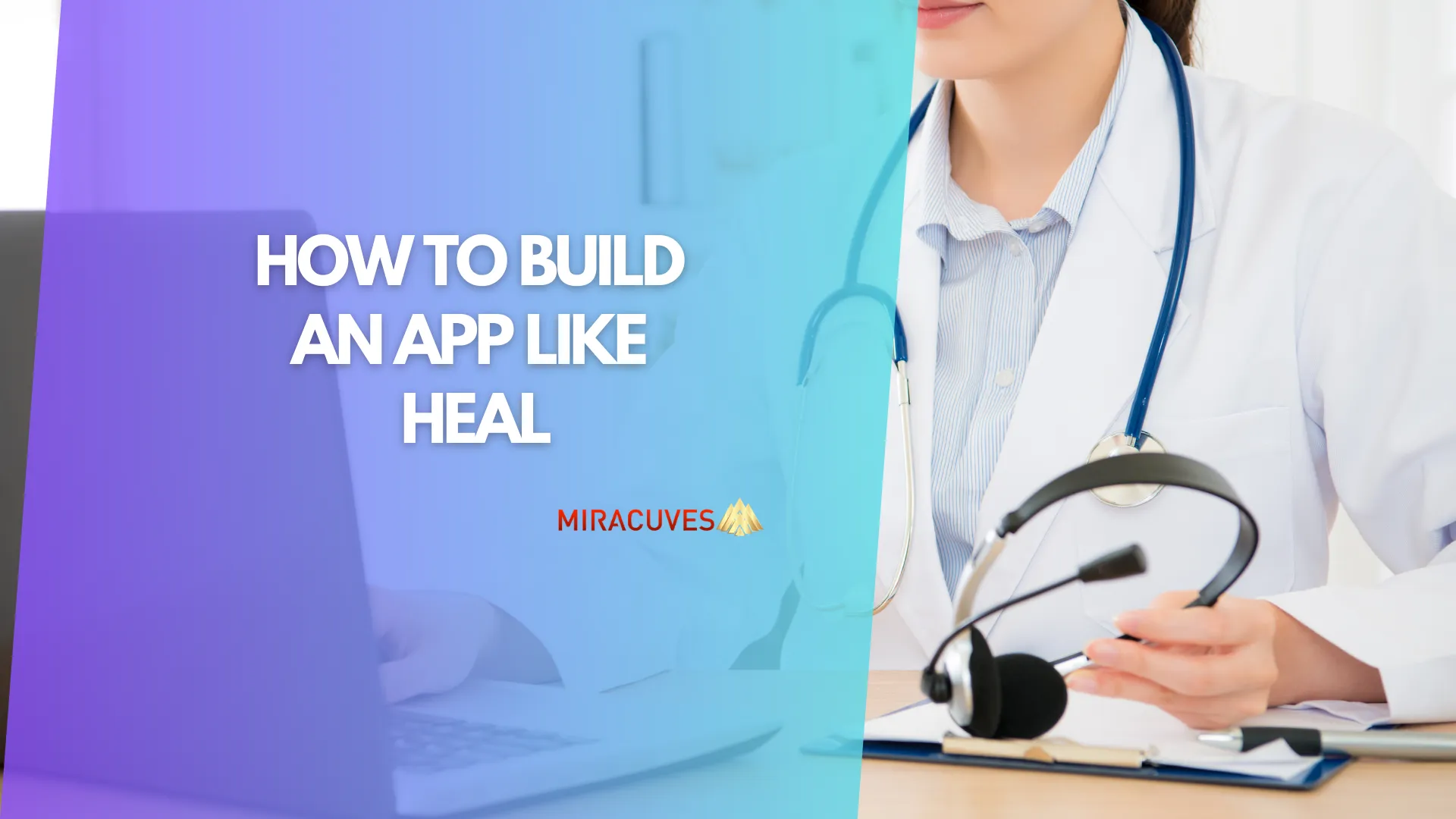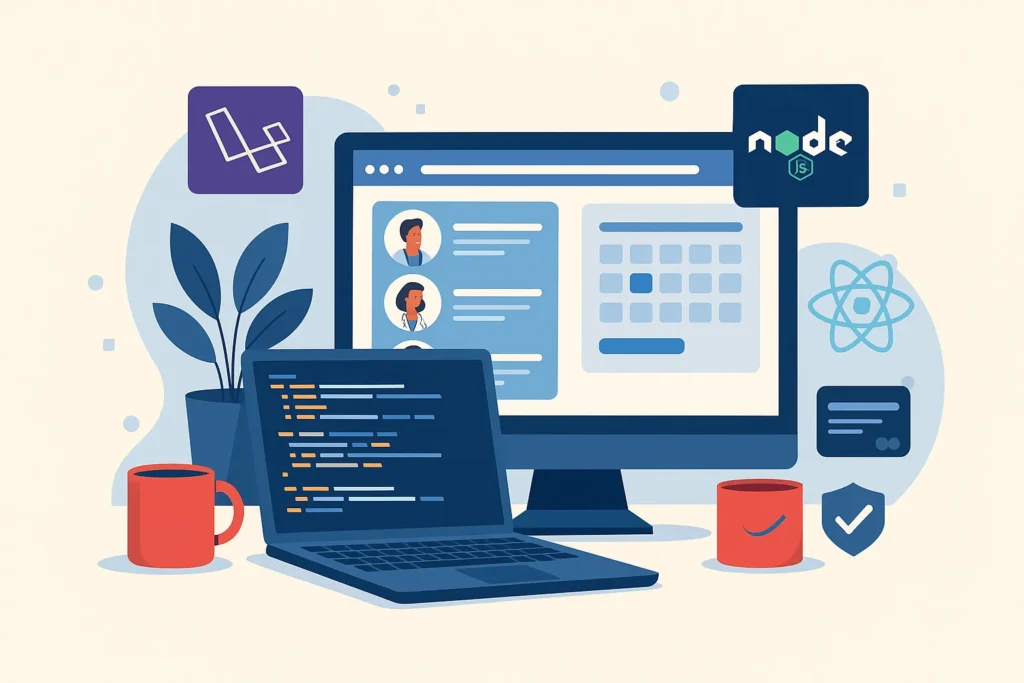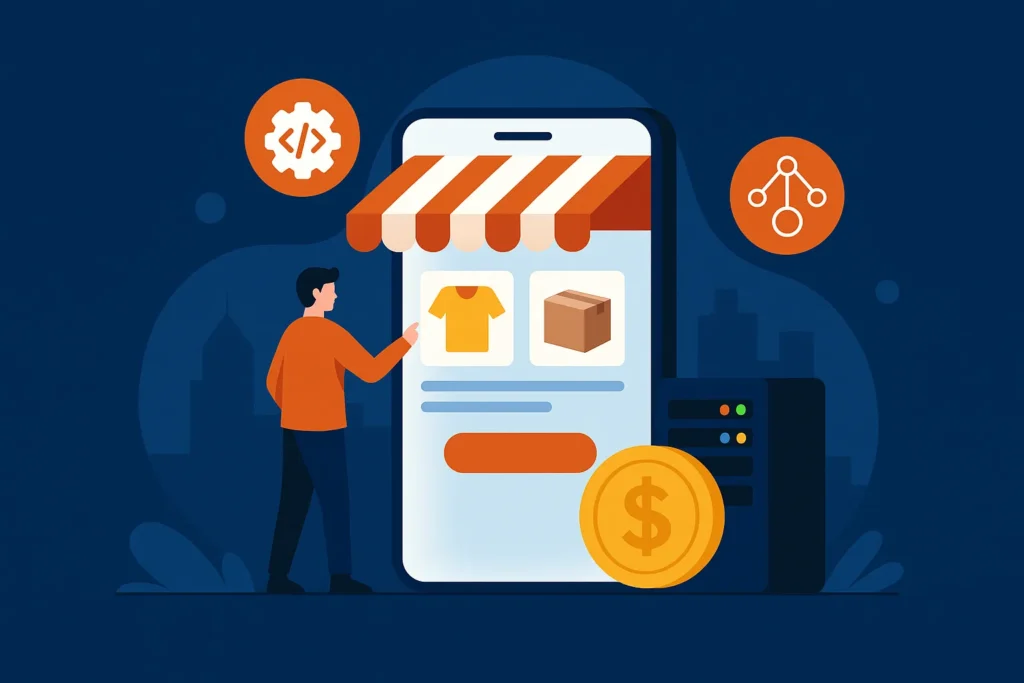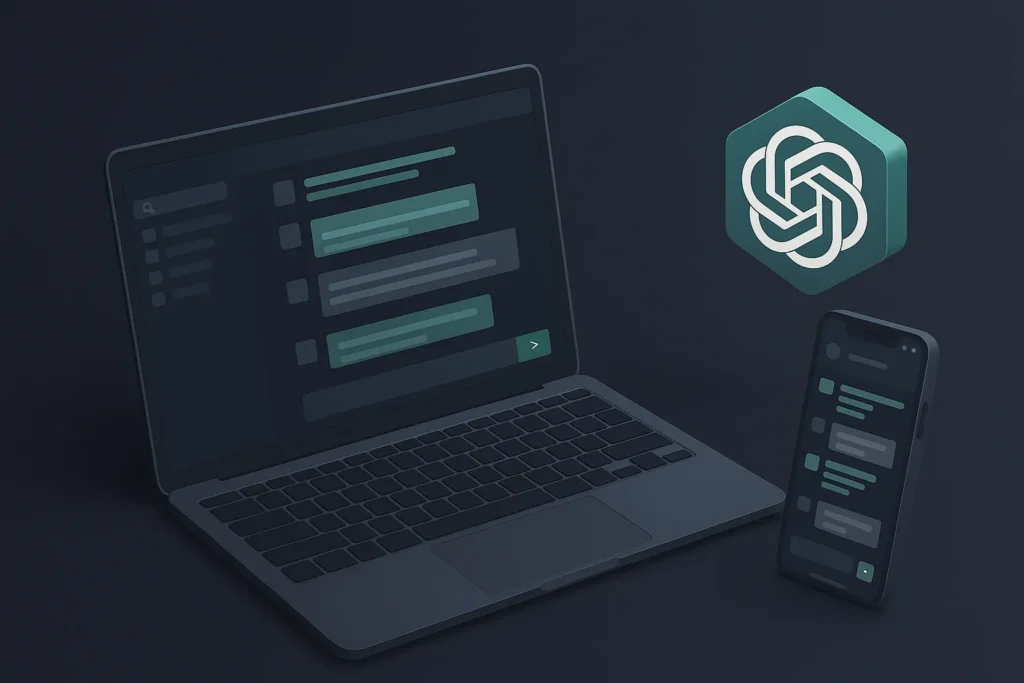In a world where convenience and accessibility drive user behavior, on-demand healthcare apps are revolutionizing how patients receive medical care. One standout example is Heal, a platform that connects patients with doctors for home visits and teleconsultations. As the demand for remote healthcare rises, building a similar app provides an incredible opportunity to enter this thriving market. With users seeking telemedicine services at their fingertips, developing a Heal-like app combines healthcare innovation with business potential.
To successfully create such a platform, businesses need to focus on designing user-friendly interfaces, choosing the right technology stack, and implementing fast, reliable services. While global development typically takes a month, Miracuves Solutions provides a faster, affordable alternative with ready-made solutions—delivering projects in just 1 day at 10% of the global cost.
This guide will walk you through the entire process—from understanding Heal’s core model to MVP development, cost analysis, and strategies to make your app stand out in a competitive healthcare market.
What is Heal, and What Does It Do?
Heal is an on-demand healthcare platform that offers patients the convenience of connecting with licensed doctors for home visits and teleconsultations. Designed to bridge the gap between traditional healthcare and modern digital solutions, Heal focuses on bringing quality medical care directly to patients’ homes. It serves as a valuable tool for those who prefer the ease of remote consultations or require at-home medical attention.
The app is a comprehensive telemedicine solution, providing services such as:
- Home visits: Schedule doctors for in-person checkups at home.
- Teleconsultations: Conduct video consultations with healthcare professionals remotely.
- Electronic medical records (EMR): Access and update patient data digitally.
- Prescription services: Get e-prescriptions that patients can use at their nearest pharmacy.
The platform’s key value proposition lies in its ability to save time, reduce hospital visits, and improve access to healthcare, especially for elderly patients, families with children, and individuals with mobility challenges. By leveraging technology, Heal offers timely healthcare solutions that eliminate the need to wait in clinics or hospitals.
Why Should You Build This App?
The healthcare industry is undergoing a massive transformation, with on-demand healthcare becoming more popular than ever. The COVID-19 pandemic has accelerated the need for remote healthcare services, making telemedicine platforms an essential part of modern healthcare. Developing an app like Heal allows you to address critical gaps in healthcare delivery—providing convenient access to doctors, reducing hospital congestion, and improving patient outcomes.
Additionally, on-demand doctor apps cater to a diverse range of users, including:
- Elderly patients who prefer home visits for health check-ups.
- Busy professionals who opt for teleconsultations over in-person visits.
- Parents with children looking for quick healthcare services.
- Patients in remote areas with limited access to healthcare facilities.
Business Value of Building a Heal-Like App:
- Market Demand: With telemedicine services booming, healthcare apps are expected to grow rapidly in the coming years.
- Revenue Potential: The app can generate income through consultation fees, subscription plans, and corporate healthcare services.
- Innovation Opportunities: Adding features like AI-powered health monitoring or wearable integrations can further enhance the user experience.
By building an app like Heal, you not only address the growing need for remote healthcare but also create a profitable, future-proof business.
| Aspect | Traditional Healthcare | On-Demand Healthcare (Heal-like App) |
|---|---|---|
| Access to Care | Requires visiting a clinic or hospital | Available anytime through mobile devices |
| Convenience | Limited by location and working hours | 24/7 availability for consultations and bookings |
| Waiting Time | Can involve long queues and delays | Minimal wait with scheduled appointments |
| Healthcare Delivery | In-person only | Offers both home visits and teleconsultations |
| Patient Demographics | Primarily local patients | Accessible to patients from remote locations |
| Medical Records | Paper-based or fragmented systems | Integrated digital records (EMR) available |
| Cost of Services | Often higher due to operational expenses | More cost-effective with reduced overheads |
| Scope of Services | Requires physical presence for most treatments | Covers many cases remotely (e.g., flu, consultations) |
How to Differentiate Your App from Competitors
In the competitive landscape of telemedicine and on-demand healthcare, standing out is crucial for success. Simply replicating features won’t be enough; your app needs unique elements that attract users and provide added value. Here are some ideas to help you differentiate your app from competitors:
1. Personalization Through AI
- Implement AI-powered health assistants that offer personalized health tips based on patient data.
- Use machine learning algorithms to predict patient needs and suggest relevant healthcare services.
2. Integration with Wearables and IoT Devices
- Allow patients to sync their smartwatches and fitness trackers with the app to monitor heart rate, steps, and sleep patterns.
- Real-time health tracking ensures better consultation experiences and allows doctors to make more informed decisions.
3. Subscription Plans and Membership Programs
- Offer subscription-based healthcare plans with discounts on home visits and consultations.
- Introduce loyalty programs that reward frequent users with free or discounted services.
4. Mental Health Services
- Expand beyond physical health by including mental health consultations, offering video therapy sessions and mindfulness programs.
By incorporating these features, your app will not only meet user expectations but also provide a fresh, innovative experience that goes beyond what existing platforms like Heal offer.
| Feature | Heal | Your App (Heal Competitor) |
|---|---|---|
| Doctor Home Visits | Yes | Yes |
| Teleconsultations | Yes | Yes |
| Electronic Medical Records (EMR) | Yes | Yes, with AI-powered insights |
| AI-Powered Health Assistant | No | Yes, personalized health recommendations |
| Wearable Device Integration | No | Yes, real-time health monitoring |
| Subscription Plans | No | Yes, with exclusive discounts |
| Loyalty Programs | No | Yes, rewards for frequent users |
| Mental Health Services | Limited | Yes, with therapy sessions and mindfulness programs |
| Cost | Market Standard | 10% of global cost with faster delivery (via Miracuves Solutions) |
| Delivery Time | Standard (1 Month) | 1 Day with ready-made solutions (via Miracuves Solutions) |
Read More “How to Build an App Like Doctor on Demand: Features, Cost, and Development Process“
Market Size, Growth, and Revenue Model
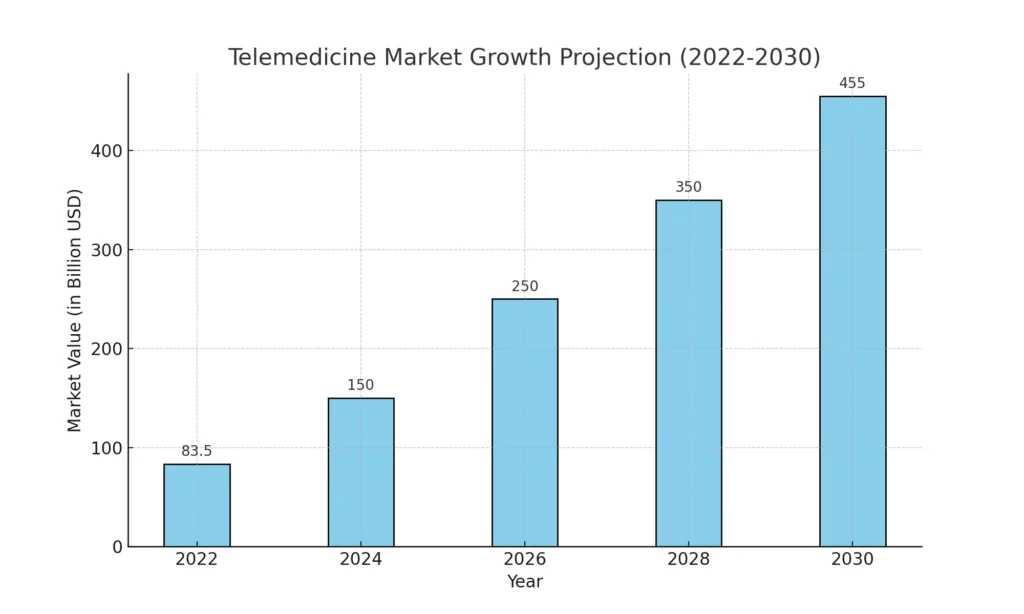
The telemedicine and on-demand healthcare market is experiencing rapid growth, driven by technological advancements and changing consumer behavior. According to industry reports, the global telehealth market was valued at $83.5 billion in 2022 and is expected to reach $455 billion by 2030, with a compound annual growth rate (CAGR) of 24%. This surge reflects increasing demand for remote consultations, digital health tools, and personalized healthcare solutions.
Key Market Drivers
- Post-Pandemic Shift: The COVID-19 pandemic changed healthcare dynamics, with more patients and providers preferring virtual consultations.
- Growing Internet and Smartphone Penetration: Easy access to mobile devices boosts adoption of telehealth platforms.
- Rising Chronic Illnesses: Patients with chronic conditions require frequent consultations, making remote healthcare ideal.
- Government Initiatives: Governments worldwide are investing in telemedicine infrastructure and offering subsidies to promote digital healthcare adoption.
Revenue Models for Your On-Demand Doctor App
- Pay-per-Consultation: Patients pay a fee for each home visit or teleconsultation.
- Subscription Plans: Offer subscription-based healthcare packages for regular users, including discounts and priority services.
- Corporate Packages: Partner with companies to provide employee healthcare solutions through the app.
- Pharmacy and Lab Integrations: Generate revenue through partnerships with pharmacies and diagnostic labs for prescription fulfillment and tests.
With these trends and revenue models, your app has immense potential to capture market share by providing high-quality, accessible healthcare services to a wide range of users.
Leads to a comprehensive industry report on the telemedicine market, offering market insights and statistics that support the section.
Features of the App
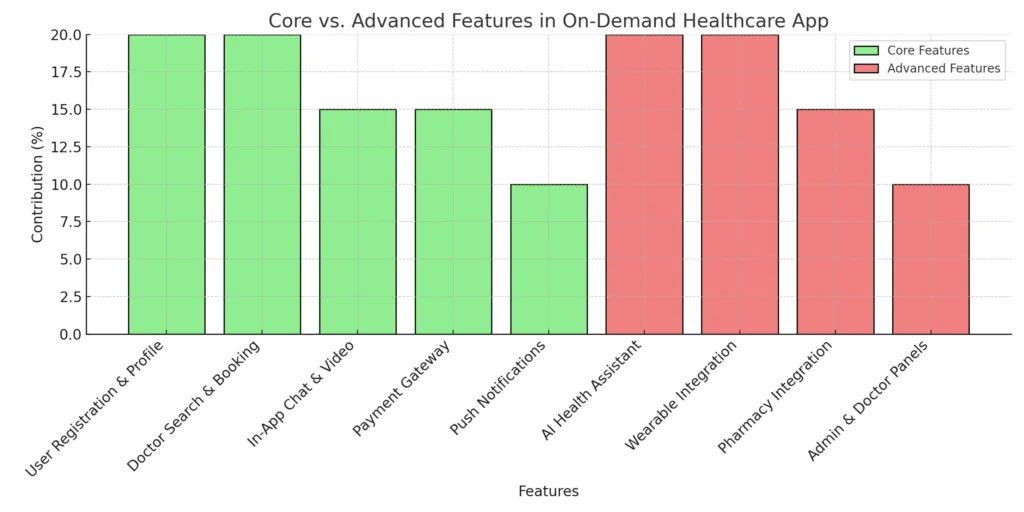
To build a successful on-demand healthcare app like Heal, the features must prioritize user convenience, accessibility, and seamless interaction between patients and doctors. Below is a breakdown of the core and advanced features that make such an app effective:
Core Features
- User Registration and Profile Management:
- Easy sign-up with email, phone, or social accounts.
- Manage personal details, medical history, and payment options.
- Doctor Search and Booking System:
- Users can search for doctors by specialty, location, and availability.
- Book appointments for home visits or online consultations.
- In-App Chat and Video Consultation:
- Real-time chat and video call options for remote doctor consultations.
- Send and receive messages, medical files, and prescriptions.
- Secure Payment Gateway:
- Integrated payment options (credit cards, wallets) with encrypted transactions.
- Push Notifications and Reminders:
- Alerts for upcoming appointments, new messages, and follow-ups.
Advanced Features
- AI-Powered Health Assistant:
- Provides personalized health recommendations based on user data.
- Wearable Device Integration:
- Sync with fitness trackers to monitor real-time health metrics (heart rate, sleep).
- Pharmacy and Lab Integration:
- Order prescriptions or schedule diagnostic tests through the app.
- Multiple User Panels:
- Separate interfaces for patients, doctors, and admins to manage activities smoothly.
Technical Requirements
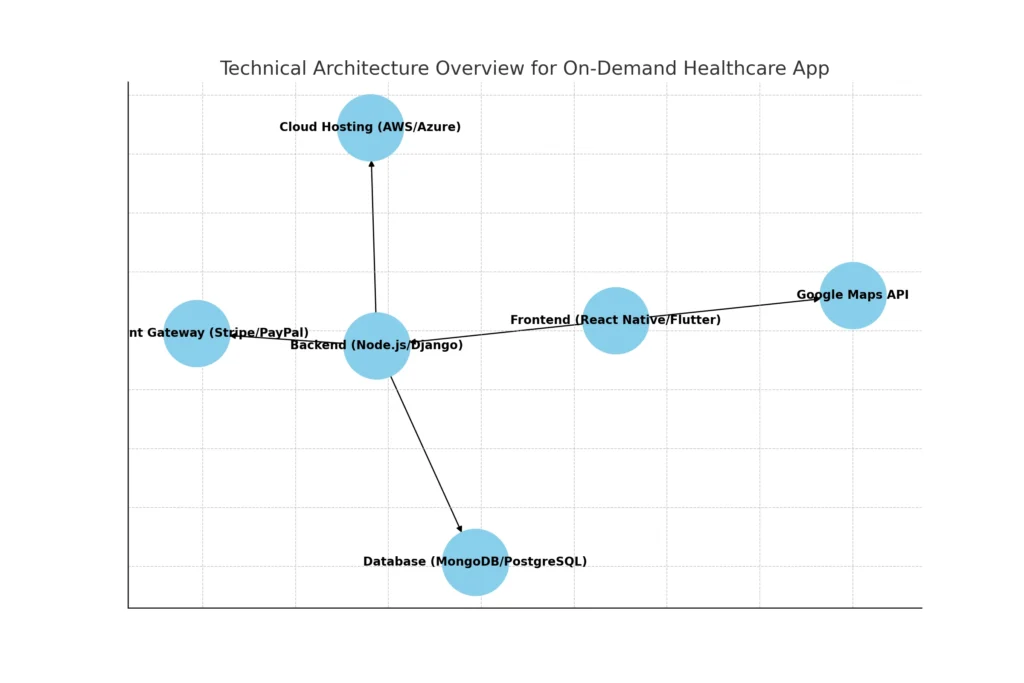
Building a reliable and scalable on-demand healthcare app requires selecting the right tech stack and infrastructure. This ensures smooth operations, fast response times, and secure handling of sensitive health data. Below are the key technical components required to develop an app like Heal:
Recommended Tech Stack
- Frontend Technologies:
- React Native or Flutter for cross-platform development, providing a seamless experience on both iOS and Android.
- HTML5, CSS3, and JavaScript for web interfaces (if the app includes a web version).
- Backend Technologies:
- Node.js or Django to handle server-side logic and API requests efficiently.
- Firebase for real-time data synchronization.
- Database:
- MongoDB or PostgreSQL for secure storage of user and medical data.
- APIs and Integrations:
- Google Maps API for location tracking and scheduling home visits.
- Payment gateways like Stripe or PayPal for secure transactions.
Security and Compliance
- Implement encryption protocols (AES-256) to secure data transmissions.
- Ensure the app is compliant with HIPAA (in the US) and GDPR (in Europe) for data privacy.
Infrastructure
- Cloud Hosting: AWS or Microsoft Azure for reliable and scalable hosting solutions.
- Load Balancers: To manage traffic efficiently during peak usage.
This robust tech stack ensures your app operates smoothly, meeting user demands while maintaining high levels of security and reliability.
Design and User Interface
A healthcare app like Heal must have a simple, intuitive, and engaging design to provide a seamless user experience. Since patients of different age groups and technical proficiency will use the app, the user interface (UI) needs to be easy to navigate, while the user experience (UX) ensures that each action flows logically.
Key Principles of App Design for Healthcare
- User-Centered Design:
- Make the interface simple and clear, with minimal steps to access services like booking a consultation or scheduling a home visit.
- Accessibility and Inclusivity:
- Ensure the app is usable for everyone, including those with visual or motor impairments (using larger fonts, voice input, or dark mode).
- Consistent Color Scheme:
- Use soothing colors like blue and green to convey trust and wellness. Maintain consistent branding throughout the app.
- Fast Load Times:
- Optimize app performance to reduce loading screens and deliver a snappy, responsive experience for users.
- Easy Navigation with Intuitive Icons:
- Use familiar icons for actions (e.g., phone for contact, calendar for appointments) to enhance usability.
- Interactive User Dashboard:
- Provide users with easy access to health records, appointments, and notifications in one place.
With these principles in place, your app will offer a frictionless experience that encourages users to return and recommend the service to others.
Development Process
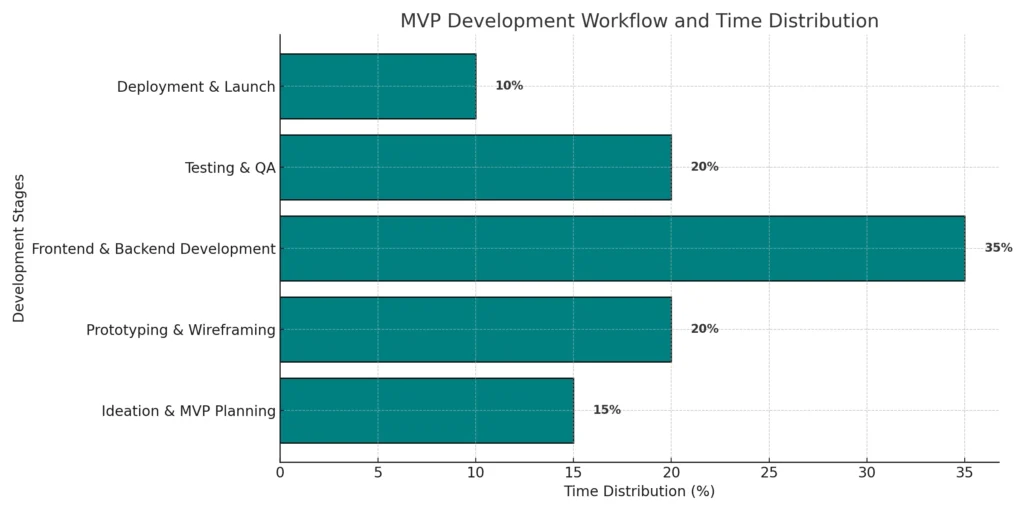
Building an on-demand healthcare app like Heal involves several critical steps, from initial planning to final deployment. Following a structured development process ensures the app is functional, secure, and user-friendly upon launch. Below is the step-by-step workflow that guides you from concept to completion:
1. Ideation and MVP Development
- Start by identifying the core features that your app must have, such as teleconsultations, doctor booking, and payment integration.
- Develop a Minimum Viable Product (MVP) to test your idea in the market with basic functionalities. This allows you to gather user feedback and make improvements before full-scale development.
2. Prototyping and Wireframing
- Create wireframes to visualize the app’s design and user flow.
- Use prototypes to simulate how the app will function, allowing stakeholders to provide input early in the design phase.
3. Frontend and Backend Development
- The frontend (React Native/Flutter) ensures the app works smoothly on both Android and iOS devices.
- The backend (Node.js/Django) handles user data, scheduling, and real-time interactions.
4. Testing and Quality Assurance (QA)
- Conduct multiple rounds of testing, including performance, usability, and security tests.
- Fix bugs and optimize the app to ensure a smooth user experience.
5. Deployment and Launch
- Launch the MVP first to gather feedback and validate market needs.
- Roll out the full version with advanced features after refining the initial product.
Looking to create a digital health platform like Heal?
Our team specializes in healthcare app development,
from HIPAA compliance to real-time patient support.
Cost Estimation and Timeframe
When it comes to app development, cost and time are the most critical factors for businesses. Building a feature-rich healthcare app like Heal typically involves significant investment and time, but there are smart ways to reduce both without compromising quality.
Global Cost vs. Miracuves Solutions Cost
- Global development cost: Building an on-demand healthcare app with custom features and backend services can cost around $6,000 to $10,000.
- Miracuves Solutions cost: By leveraging ready-made solutions and efficient processes, the same app can be developed for just $600, which is 10% of the global cost.
Development Time Comparison
- Traditional development time: On average, it takes 1 month to build and deploy a healthcare app like Heal using traditional methods.
- Miracuves Solutions timeframe: Miracuves Solutions delivers the same app within just 1 day, thanks to its ready-made frameworks and fast-track development process.
What Drives These Savings?
- Ready-made Solutions: Using pre-designed components cuts down design and development time.
- Optimized Processes: Automated tools and scalable solutions reduce manual effort.
- Fast Deployment: Streamlined testing and quality assurance ensure quick rollouts.
By choosing Miracuves Solutions, businesses can save both time and money, making it possible to launch their app faster and start generating revenue sooner.
Read More : HealthifyMe Business Model Explained: How It Works and Generates Revenue
Why Trust Miracuves Solutions for Your Next Project?
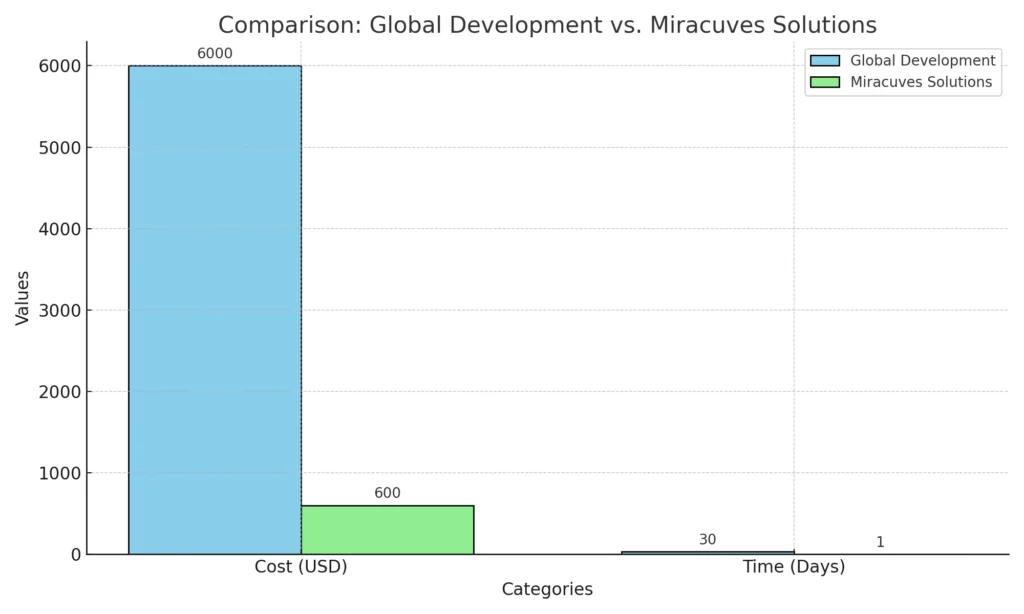
When it comes to developing an on-demand healthcare app like Heal, choosing the right development partner is crucial. Here’s why Miracuves Solutions is the ideal choice for your project:
1. Proven Expertise in Healthcare App Development
Miracuves Solutions specializes in building custom healthcare applications that address market demands. With a portfolio of successful projects, the company knows exactly what it takes to develop secure, scalable, and user-friendly apps.
2. 10% of Global Development Cost
Traditional app development can drain resources, but with Miracuves Solutions, you get the same high-quality output at only 10% of the global cost. This allows businesses to invest more in marketing and growth while still launching a top-notch product.
3. 30x Faster Delivery
While standard app development can take weeks or even months, Miracuves Solutions leverages ready-made solutions and streamlined processes to deliver fully functional apps within 1 day. This speed helps businesses capitalize on market trends without delays.
4. Customizable and Scalable Solutions
Unlike rigid solutions, the solutions offered by Miracuves Solutions are highly customizable to meet specific business needs. As your app grows, it can scale effortlessly to accommodate new users and features.
5. Security and Compliance at the Core
Miracuves Solutions ensures that all healthcare apps comply with HIPAA, GDPR, and other local health regulations, giving users and businesses peace of mind when handling sensitive data.
With affordable pricing, rapid delivery, and reliable security, Miracuves Solutions is the perfect partner to help you launch your healthcare app with confidence.
Monetization Strategies
Creating a successful healthcare app like Heal is not just about providing medical services—it’s also about building a sustainable business model. Here are some monetization strategies that can generate consistent revenue for your app:
1. Pay-per-Consultation Model
- Charge patients for each consultation or home visit.
- Transparent pricing builds trust and helps users pay only when they need services.
2. Subscription Plans
- Offer monthly or yearly subscription packages with perks such as discounted consultations or priority bookings.
- Subscription plans encourage user retention and recurring revenue.
3. Corporate Healthcare Packages
- Partner with companies to provide healthcare services for employees.
- Corporate clients pay a fixed fee to cover employee wellness, adding a B2B revenue stream.
4. Commission from Partnered Pharmacies and Labs
- Collaborate with pharmacies and diagnostic centers, earning commissions for each transaction or test booked through the app.
5. In-App Advertising
- Offer targeted advertising for healthcare-related products, such as wellness programs or fitness equipment.
- Ensure ads are non-intrusive to maintain a seamless user experience.
These strategies provide multiple streams of income, ensuring your app remains profitable and scalable while delivering valuable healthcare services.
Launching and Marketing the App
A successful launch is just the beginning—effective marketing ensures your app gains traction and attracts users. Here’s a step-by-step approach to launching and promoting your healthcare app:
1. Pre-Launch Strategy
- Beta Testing: Release a beta version to a select group of users to gather feedback and fix any last-minute issues.
- App Store Optimization (ASO): Optimize your app’s title, description, and keywords to improve visibility in app stores.
- Teaser Campaigns: Generate excitement with social media posts, email marketing, and influencer collaborations before the official launch.
2. Launch Day Activities
- Press Release: Announce the launch through a press release shared with media outlets.
- Social Media Takeover: Engage with your audience by promoting the app launch on social platforms like Instagram, Twitter, and LinkedIn.
- Exclusive Offers: Offer launch-day discounts or free consultations to encourage downloads.
3. Post-Launch Marketing
- Paid Ads Campaigns: Run targeted ads on Google, Facebook, and Instagram to attract early users.
- Referral Programs: Encourage users to invite others with incentives like free consultations or credits.
- Partnerships with Healthcare Providers: Collaborate with clinics and pharmacies to co-promote the app and provide bundled services.
A well-planned marketing strategy ensures your app reaches the right audience, resulting in early traction and sustainable growth. Continuous engagement with users through updates, rewards, and promotions will keep them coming back.
Legal and Regulatory Considerations
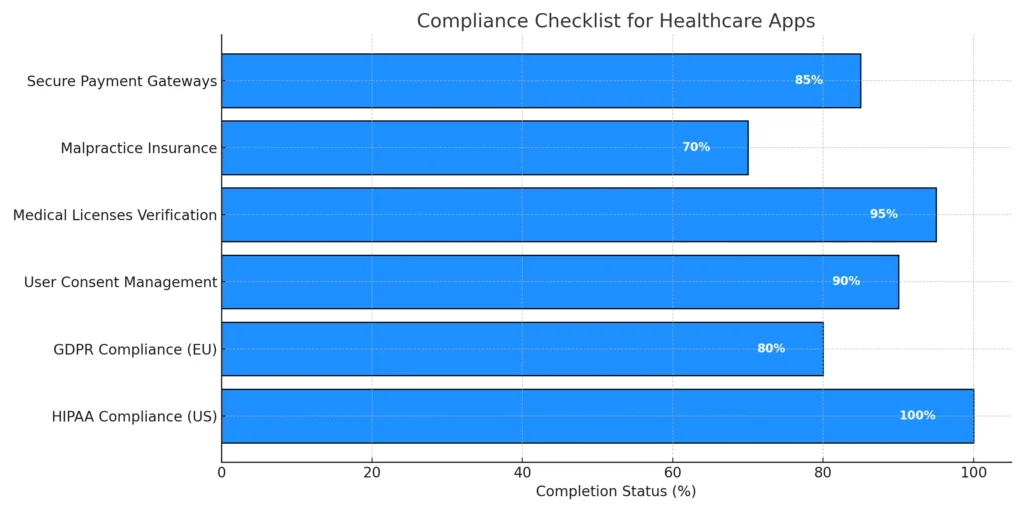
When building a healthcare app, compliance with legal and regulatory frameworks is critical. Healthcare apps handle sensitive medical data, so ensuring security, privacy, and regulatory adherence is non-negotiable. Here’s a breakdown of the legal requirements and standards your app must meet:
1. Data Privacy Regulations (HIPAA/GDPR)
- HIPAA (Health Insurance Portability and Accountability Act): If your app operates in the US, it must comply with HIPAA to protect patient data and ensure confidentiality.
- GDPR (General Data Protection Regulation): For apps operating in Europe, GDPR compliance is essential to safeguard user data and maintain transparency.
2. User Consent and Data Handling
- Implement clear terms of service and privacy policies outlining how user data will be collected, stored, and used.
- Ensure that users provide explicit consent before sharing their medical information.
3. Medical Licenses and Certifications
- Ensure that all healthcare providers on the platform hold valid medical licenses.
- Display verified credentials and certifications to build user trust.
4. Liability and Malpractice Protection
- Include disclaimer clauses in your terms of service to define the scope of liability.
- Consider providing malpractice insurance coverage for healthcare professionals on the platform.
5. Payment and Tax Compliance
- Follow local laws for digital payments and tax reporting.
- Use secure payment gateways that meet regulatory standards to prevent fraud.
Compliance with these laws ensures your app operates legally and maintains user trust, paving the way for smooth operations across different regions.
Directs users to the official website for HIPAA regulations, providing in-depth compliance information for healthcare apps.
Future Growth and Trends
The future of healthcare apps is incredibly promising, with telemedicine and on-demand healthcare becoming more advanced every year. As technology evolves, healthcare apps are integrating AI, wearable devices, and personalized care models to provide users with seamless, efficient, and predictive healthcare solutions. Here are the key trends that will shape the future of your app:
1. AI-Powered Diagnostics and Chatbots
- AI algorithms will assist doctors in diagnosing diseases faster by analyzing patient data and symptoms.
- Chatbots powered by AI will provide instant health advice and triage, reducing waiting times for users.
2. Integration with Wearables and Remote Monitoring
- Wearable devices like smartwatches and fitness bands will play a bigger role in monitoring patient health metrics in real-time.
- These devices will transmit vital health information directly to doctors, enabling early intervention.
3. Expansion into Mental Health and Wellness
- Mental health services are gaining popularity, and video therapy sessions will become a standard feature in healthcare apps.
- Apps will also offer wellness programs such as guided meditation, stress tracking, and lifestyle coaching.
4. Personalized Healthcare with Big Data
- By analyzing user data trends, apps will provide highly personalized healthcare recommendations, aligning treatments with individual needs.
5. Blockchain for Enhanced Data Security
- Blockchain technology will ensure secure data sharing and improve user trust by creating tamper-proof medical records.
These trends indicate that the healthcare apps of tomorrow will go beyond basic consultations, offering personalized care, predictive diagnostics, and enhanced security.
Related Posts :-
- How to Build a Virtual Healthcare App Like Zocdoc for Medical Scheduling
- Build a Telehealth App Like Amwell: Features, Cost, and Timeline
- Step-by-Step Guide to Building a Remote Healthcare App Like Teladoc
Conclusion
Creating an on-demand healthcare app like Heal offers a unique opportunity to bridge the gap between traditional healthcare and modern telemedicine. With the growing demand for remote consultations, doctor home visits, and real-time health monitoring, this is the perfect time to enter the market. By following a structured development process—from building an MVP to adding unique features like AI-powered diagnostics and wearable integration—you can create an app that offers exceptional user experience and real value to patients.
Choosing the right development partner is crucial, and Miracuves Solutions ensures your app is built 30x faster and at 10% of the global cost, allowing you to focus on scaling and growing your business. Whether through subscription models, corporate healthcare packages, or pharmacy partnerships, your app will unlock multiple streams of revenue.
With the right design, marketing strategy, and legal compliance, your app can stand out in a competitive market, gaining user trust and loyalty over time. The future of healthcare is personalized, accessible, and digital, and your app could play a key role in shaping that future.
Launch your healthcare app faster with our pre-built solution inspired by Heal!
Build your Heal-like healthcare platform in days—not months—with our pre-built app.
FAQs
What is the estimated cost of building an on-demand healthcare app?
The global cost can range from $6,000 to $10,000, but Miracuves Solutions offers the same app development for just $600.
How long does it take to develop an app like Heal?
Traditional development takes around 1 month, but Miracuves Solutions can deliver your app in just 1 day using ready-made frameworks.
Can I customize the app solutions to suit my business needs?
Yes! The solutions provided by Miracuves Solutions are highly customizable to meet your specific business requirements.
What legal requirements should I consider for my healthcare app?
You must comply with HIPAA (US) and GDPR (EU), along with ensuring all healthcare providers on the platform hold valid licenses.
How can I monetize my on-demand healthcare app?
You can generate revenue through consultation fees, subscriptions, corporate healthcare packages, and partnerships with pharmacies and labs.
Explore innovative healthcare platforms by Miracuves – designed for efficiency, accessibility, and seamless care delivery:
Netmeds Like Platform – A hassle-free medicine ordering platform with doorstep delivery, prescription uploads, and a user-friendly interface.
Practo Like Platform – A complete platform for booking doctor appointments, managing health records, and accessing telemedicine services.
PharmEasy Like Platform – A versatile platform for medicine delivery, diagnostic test bookings, and healthcare essentials all in one.
Lybrate Like Platform – A comprehensive platform to connect with doctors, get real-time medical advice, and manage follow-ups easily.



